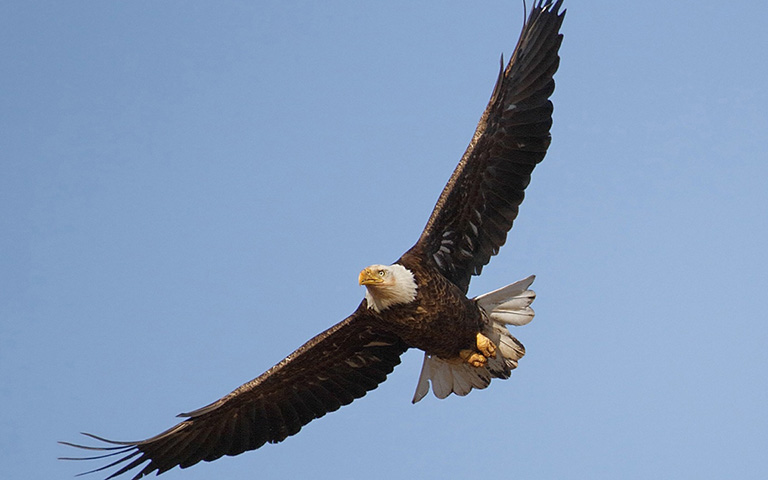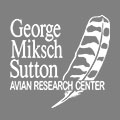READ THE FULL STORY
How can your organization duplicate these incredible results?
Get details on how Sutton Center:
- accomplished its goals
- invested money wisely
- reinvested in mobile technology by partnering with UScellular for wireless solutions.
The Eagles Have Landed at UScellular
The George Miksch Sutton Avian Research Center (Sutton Center), a leader in avian research and conservation, has been filming and broadcasting eagles since 2006— first from a nest in Tulsa and other locations, then later from Sequoyah National Wildlife Refuge, and now in Bartlesville, in northern Oklahoma near its headquarters.
The Sutton Center conducts intensive, conservation-oriented, ecological field research on declining grassland birds, developing and applying techniques for the reintroduction and monitoring of Southern Bald Eagles. It is credited with bringing the eagle back from extinction in the central U.S., according to Audra Fogle, Assistant Director.
“When we started with the eagles, there were none breeding in this part of the country. They were completely extinct as a nesting species because of DDT” (the chemical formerly used in mosquito spray). “When we began to bring them back, we thought we would be successful if we had 10 nests in Oklahoma. That was our benchmark for success. Today, we have documented more than 300 nests in Oklahoma alone and we have a team of citizen scientists called the Bald Eagle Survey Team that help us monitor those nests and contribute to the national database,” Fogle said.
As the center experienced success, they decided to share it with the world by transmitting images of eagles in a nest in the Sequoyah wildlife refuge. “Our old system relied on batteries and solar power, and the ants were always destroying the electronics,” said Fogle. “We were continually replacing equipment.” The eagles then relocated their nest and the Center no longer films at the refuge, but might again in the future.
Upgrading to Cellular Connections
Instead, in January 2020, the Center set up a camera over a nest in Bartlesville that staff can view from their admin building. “It’s really nice to be able to see the eagles in person that you’re actually filming. We can see them and easily go check the nest,” she said.
Rather than hardwire, a former staff member chose cellular connectivity with another major carrier. But there were numerous issues with their first choice of company. “They assured us it would all be fine, but we couldn’t keep a signal, so the camera did not work. It went down all the time,” Fogle said.
That’s when she looked around the office in rural, remote Oklahoma and recognized a common theme. “We all have UScellular coverage on our phones because the Sutton Center is located in the boonies. There are several cellular providers that just don’t work well here. The topography is very wooded, a lot of hills, lot of rocks.
“UScellular has the best service in our area. That’s why we started using them for our phones in 2010 and that’s why, once we tried the other provider, we didn’t know why we hadn’t been using UScellular for the eagle cam in the first place,” Fogle said
Frustrated by the inconsistent service and outages from their first provider, Fogle grabbed her eagle puppet (from a fundraising event) and drove to the nearby UScellular office. “I told my story, and it was really fun because they all started working on how they could help connecting us better,” she said.
Next, the staff contacted Account Manager Cory Snelson to take charge. Fogle said the staff was provided a UScellular SIM card to insert into the router so that they could test it and make sure it would work in their location, “in a pasture in the middle of nowhere.” And it did.
After two years of inconsistent service from their previous cellular company, they switched to UScellular in January 2022 and have since enjoyed continuous and reliable service.

Setting up the camera that sits above the nest.
Photo by Dan Reinking.
Getting Results with UScellular Connectivity
The Wi-Fi “eagle cam” is mounted to a higher branch above the nest and attaches to the router in which the UScellular SIM card is placed, providing cellular connectivity to the internet.
The results with UScellular have been overwhelming. “We stopped getting a million complaints that the camera wasn’t working,” Fogle said.
“The camera has stayed pretty consistently online and recording. That’s huge because we’ve had over one million views on our camera from people all over the world. And when the camera goes down, we get so many unhappy phone calls or people saying, ‘did you know your cameras not working?’ We have saved time and hassle just not having to constantly answer questions.
“It’s not professional when your camera’s not working. Having a camera that works constantly reflects who we are as an organization,” Fogle said.

This chart demonstrates the success of reintroducing bald eagles to Oklahoma.
The Sport of Eagle Watching
Watching the eagle cam can admittedly become addictive. The majestic birds (who the Center does not name) display so many fascinating characteristics including one male who was reprimanded by the female for being gone too long.
“She gives him the what-for and chases him all the way out to the end of the branch and it takes him all day to work his way back to the nest,” Fogle said, laughing. “Stories like that are so fun and you see those personalities come out and for us that helps with our whole message of wildlife conservation. Because if people don’t have a personal connection, it’s very easy to not care.
“The eagle cam helps us to establish personal connections with the bald eagle so we can continue conservation, working together to make a difference,” Fogle said. Nesting season for eagles is typically January-May. Courtship begins in mid-December when they lay up to three eggs.

A majestic bald eagle.
Photo by Jim Arterburn.
Other Modernization Considerations
Fogle added that the Sutton Center is having issues with its traditional hard line phone system. “We have so many problems, plus the phones are ancient.” She and Snelson are discussing a global VoIP system with unified communications that also would save them money with UScellular. “We’re hoping that whenever it rains, we still can use our phones because right now, it takes out a line.” she said.
In the meantime, the eagles are online for the world to view.












